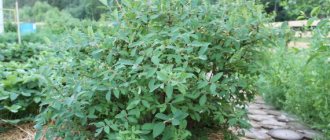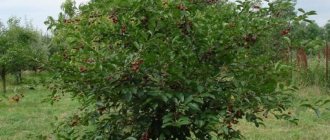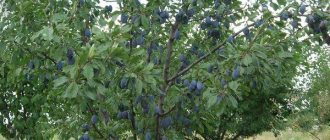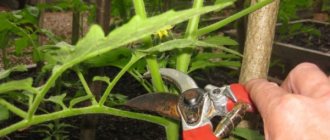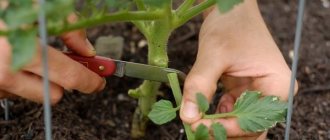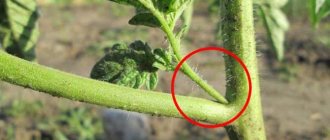Schemes for pruning hazelnuts in the fall will help novice gardeners correctly form a productive plant. Everyone independently chooses what shape to give the seedling, bush or standard. Thanks to regular pruning in the fall, the long-lasting garden form of hazelnut will provide fruit for several decades.
Why do you need autumn pruning of hazelnuts?
Caring for any tree or bush includes regular pruning. Hazelnut bushes, a garden form of hazel, which is pollinated by the wind, are also thinned. A good result will be if the crown is not thickened and the leaves do not interfere with the movement of pollen. Pruning hazelnuts in autumn helps:
- more efficient plant development;
- early entry into fruiting;
- better yield;
- good ripening of wood and fruits;
- increasing the lifespan of the plant;
- improving winter hardiness;
- resistance to fungal diseases and pests.
Pruning, which is carried out in the fall, regulates the timing of the spring growing season of hazelnuts, including the beginning of flowering and the development of branches. The goals that the gardener achieves:
- the formation of a sparse light crown, where sunlight and air flows freely enter;
- stimulating the growth of more short fruiting branches at the tops of all shoots.
Attention! The most productive are fairly mature branches of medium growth vigor.
Bush formation
Such a tree grows freely in all directions; its branches are almost never shortened, only thinned out, which is why the tree looks fluffy and slightly sloppy. The disadvantage of this method is that it is difficult to remove nuts from such a bush.
- After planting, the tree is pruned by 15 cm so that the root shoots develop more actively and the side branches grow better. Soon shoots will grow, which will then form a crown.
- By the 2nd year, active formation of root shoots begins, which is cut off and used for hazelnut propagation or eliminated.
- The main concern of a summer resident is to thin out the bushes. Especially lush shrubs with 12 trunks bring a very small harvest and its fruits taste noticeably different from ordinary nuts. To prevent this from happening, 6 or 8 of the shoots are selected that are strongest and well spaced from each other. The side branches of each trunk are cut to 3 buds.
- If the shrub is formed in the shape of a boat, then the branches that develop inward are removed, and the central ones are shortened so that they branch more strongly. The trunks are deflected on the sides and secured with wire. As a result, the shrub is shaped like a boat. With this formation, the hazel tree takes up very little space and several more hazelnuts can be planted next to it.
- To form a plant in the form of a vase - the most common form - all branches growing inward are eliminated, and the central shoots of the branches are cut to the outer bud. Always cut out excess, thickening shoots. The side stems are bent so that the bush ends up resembling a vase.
The hazel bush develops more actively in height and width, taking up more space. Bush hazel is not easy to care for, especially to collect the nuts, so they do not pick them, but wait until they can be shaken off. In the case of hazel bushes, gardeners thin out the crown and shorten the shoots. Pruning is carried out so that shoots grow abundantly in the crown and to reduce the height of the plant.
After 2-3 years from the moment of planting, shoots begin to form, which are removed or used as planting material. It should be borne in mind that the more thickened the bush, the lower the yield. Productivity will be higher provided that the trunks grow and position correctly. Remove strong shoots (6-8), growing far from each other.
1. In the form of a vase. Every year, all branches that grow inside the bush should be removed, and the leading shoot of the branches should be cut to the outer bud. If the crown is thickened, you need to remove excess shoots inside. Some side trunks need to be bent and secured with wire. In this way, a “vase” is created, into the middle of which air and light enter.
2. In the shape of a boat. It is necessary to remove branches that grow inward and trim the leading shoots of all trunks for branching. The trunks that remain after trimming must be bent to the side and tied with wire at a height of 1.2-1.5 above the ground. Shaped bushes in the shape of a boat do not take up as much space as in the case of the first technique.
In nature, hazel grows as a bush. It is possible to preserve the natural shape of the plant on the site, but the hazelnut needs pruning even in this case. The shrub is allowed to grow freely upwards and to the sides, but they try to significantly thin out the shoots.
The post How to Prune Hazelnuts appeared first on SeloMoe.
Many physiological processes, such as increased winter hardiness and resistance to certain pests and diseases, depend on pruning.
Using the pruning method, you can bring closer or delay the beginning of plant development in spring and the timing of flowering, and regulate the beginning and end of shoot growth.
The principle of pruning in all cases is the same - creating a light, sparse crown with maximum access to air and light, as well as stimulating and forming as many young, short, overgrowing branches with fruit buds that cover the main skeletal branches as possible.
Its task is to restore the balance between the above-ground part of the plant and the root system, which was significantly damaged and reduced when digging out of the ground. And also provide conditions for the formation of the crown.
Read more: When to plant onion sets in open soil in Siberia
By shortening the shoots of planted trees, they remove the apical buds, which are the first to form leaves when they bloom, and contribute to earlier evaporation and, therefore, drying out of the plant. Pruning for 6–7 days retards the growth of the aboveground part. The fewer fine roots a seedling has, the more ruthlessly the branches need to be cut.
Thanks to pruning, the plants take root well and form strong roots. The more fine roots there are, the easier the bush will take root.
In technical terms, pruning consists of removing excess root shoots, dry, frozen, weak, broken, growing inward shoots that thicken the crown and periodically, approximately once every 25 years, rejuvenating the bushes.
When thinning, do not leave stumps and avoid large lacerations. Coat the cut areas with garden varnish or paint over them with oil paint. Hazelnuts are grown as both bushes and trees, and therefore one of two pruning systems can be used.
The first (A) belongs to the severe pruning category
A. Pruning hazelnuts into tree shape.
Formation in the form of a standard tree simplifies care, brings the beginning of fruiting closer, allows you to place a larger number of fruit-bearing specimens per unit area, which ultimately gives a higher yield per unit area. Abundant nutrition, free access of light and air to the crown ensure good annual harvests for many years.
It is better to grow both hazel and hazelnuts with a trunk of 35–40 cm and 6-7 good first-order branches, giving the plant a bowl shape. Pruning is done at the late flowering stage. During the first 4-6 years, the conductors of the main branches are shortened by about half to the outward-facing bud. The height of the tree is kept at about 2–2.
Both of them can be located several centimeters below one-year-old wood, as well as on older wood.
Young and weak side branches that bear the majority of flowers (male and female) are not pruned, but only the thickening ones are removed and the old side branches are cut into a ring. The strongest male and female inflorescences are located on moderately strong, well-ripened shoots.
Knowing this feature, when the tree reaches fruiting age (6-7 years), in the summer (August), break strong lateral growths with your hand about half their length (up to 6-8 leaves from the base) and leave them in a drooping position.
This, of course, is a very cruel method of suppressing growth, but it is believed that it promotes better ripening of the wood at the base of the broken branch and, in addition, improves the light and air conditions.
It is also argued, and probably rightly so, that after cutting out the broken parts in early spring, conditions are created for the awakening of the buds located at the base of the shoot. From these buds grow shoots of medium strength and therefore more fruitful.
| In autumn or spring, after preparing the soil, dig a hole large enough to accommodate the straightened roots. Drive in the stake. Plant the tree, pressing down the soil, tie it to a stake. | In the spring, shorten the wires by about half to the outward-facing bud. Shorten strong side branches to 3-4 buds. Remove root shoots. | In the spring, apply complex mineral fertilizer, and on acidic soil, apply lime once every three years. |
Subsequent years
| In summer (August), break strong lateral growths with your hands at about half their length (up to 6-8 leaves from the base) and leave them hanging. This opens up access to light and air deep into the crown and promotes the ripening of fruit buds. | During flowering, shorten the broken side branches to 3-4 buds. Do not prune side shoots that bear small red female flowers. Remove root suckers, dry branches, and branches that thicken the crown too much. |
B. Pruning hazelnuts into bush shape. The natural and most common form of hazel is a shrub. With this method of pruning, trees are allowed to grow almost freely in height and in all other directions. More attention is paid to thinning and less to shortening.
Pruning is generally much weaker and the trees look more like bushes. However, such trees are difficult to harvest, so the nuts are left on the tree until they can be shaken off.
The purpose of this pruning system is to maintain abundant growth of new shoots in all parts of the crown and slightly reduce the overall height of the plant. The hazel bush must be formed from the moment of planting. After planting, the seedling is pruned at 6-7 buds or at h = 15-20 cm.
- to stimulate the formation of lateral branches and activate the growth of root shoots. After this operation, young shoots grow from the rhizome - future skeleton-formers of the crown.
2-3 years after planting, mass formation of root shoots begins, which should either be removed or used as planting material. The rationing of a bush depends on its strength and the conditions in which it grows.
Too thick bushes with 12-15 trunks per unit area produce a smaller yield of fruits, and of poor quality. A large harvest comes not from a larger number of trunks, but from their position and growth force.
Depending on the characteristics of the variety, feeding area, soil conditions, 6-8 well-developed coppice shoots, located far from each other, are selected.
Timing for pruning hazel
The optimal time for planting hazelnuts is autumn. At the same time, the first pruning is carried out, proportionally leveling the ratio of the mass of branches and roots. Usually only 20 cm of shoot is left. It is very important to prune hazelnuts in the fall, starting from 5-6 years of development. The nut enters the fruiting period, which, with proper agricultural technology, can last more than 100 years. Hazelnuts are vigorously growing, especially a lot of root shoots appear. For decent yield, the crown must be lightened annually and the shoots removed.
Start pruning after leaf fall. Pruning hazel in the fall for beginners only at first seems like a complicated process. You need to carefully study the tips and diagrams and begin to form a plant. In spring, pruning is carried out in March, before flowering, and in the south even in February, if there are no severe frosts in the long-term forecast. Dried shoots treated with this special technique in August are pruned into a bud during the flowering phase. They try to leave 3-4 buds with female flowers on the branch.
Hazelnut branches are dried by breaking them off so that they do not grow in length and the wood ripens well. The procedure is carried out with the strongest growing branches. Break off their 3-5 cm tops with your hands and leave them in this form until spring pruning. The most abundant harvest is obtained on such branches.
How to care after the process?
After the process of pruning the plant, you should:
- do not allow the tree trunk circle to dry out: water abundantly and constantly;
- in spring and summer, immediately after pruning, deeply loosen the plant near the trunk, and in the fall, dig up the soil at the base;
- fertilize with nitrogen fertilizers in spring;
- ensure that the wounds after circumcision do not rot;
- mulch with sawdust and dry grass;
- weed the trunk near the root.
Hazelnut pruning schemes are quite simple and even a beginner can handle them. Carefully following the advice, sanitizing the cuts and fertilizing will bear fruit over time.
How to prune hazelnuts in the fall
It is important to carry out the first pruning in the fall when planting or in the spring on an already rooted seedling. If you leave all the branches, in the spring they will bloom leaves, which the weak roots will have to feed to the detriment of their development. In hot spring, active evaporation from leaf blades also occurs, during which the root system dries out. A plant that has undergone pruning begins its growing season a week later. At this time, the root system works almost on itself and takes root easily. The main principle of pruning hazelnut seedlings in the fall is that the fewer thin roots there are, the more shoots need to be trimmed.
In the first years of growth, a fruiting crown of 6-8 strong shoots is formed in young hazelnuts. Weak trunks are cut in the fall at ground level, as low as possible. The tops of the remaining shoots are pruned by a third of the growth in order to stimulate the appearance of overgrowing branches with fruit-bearing buds. The next year, short fruiting branches begin to grow at the tops of the skeletal branches, which must be preserved and removed only for sanitary cleaning. Well-developed side branches are pruned to the middle of their length. Carefully examine the young shoots, noting those shoots where there are female flowers. They are not pruned in the summer, but the weakest ones are removed in the fall after harvesting.
Warning! A bountiful harvest is obtained from bushes where 6-8 shoots grow spaciously and are well illuminated by the sun. In the south, 12 trunks are allowed. A shrub of 15 shoots usually produces a poorer harvest due to thickening.
How to trim hazelnuts to fit a bush
In nature, hazel grows in the form of a bush, so hazel trees are more often found with such a harmonious silhouette. The shoots are almost never cut in height; attention is paid to thinning them. The shape of the bush is created immediately after planting. The shoot is pruned low, leaving only 6-7 buds, which is approximately 14-22 cm in height. This procedure stimulates the development of side shoots and the formation of shoots that will become skeletal branches.
In the second or third year of growth, hazelnuts begin to be rationed in the fall, weak shoots and those growing in the center of the bush are removed. By opening the middle for free access to sunlight and air flow, a future successful harvest is laid. Under warm rays, the wood will ripen better and create more fruit branches and buds. This is why hazelnut pruning in the fall is mandatory, as the video for novice gardeners confirms. It is better to leave no more than 9 shoots for fruiting.
All these skeleton-forming branches are also regularly pruned in the fall to create short fruit-bearing shoots. The lateral shoots on the skeletal shoots are cut off to 3-4 buds, and the tops of these leading shoots - by 1/3 or ½ with strong growth. The cut is always made above the bud, which grows outward. The bush is formed in the form of a bowl or “boat”.
In the fall, the central conductor of the cup-shaped crown is shortened, and the highest shoot from the outer bud is bent using improvised means to free the center of the hazelnut bush. For the second type of crown, the side branches are attached to two trellises, leaving the middle open. The first type of crown is used for single-growing hazelnuts, and the second - if the bushes are planted in a row.
How to trim a hazelnut to fit a tree
This type of pruning of common hazel and hazelnuts is not so popular, but many gardeners practice it for the sake of a spectacular impression. There is an opinion that a hazelnut standard in the same conditions with a bush formation is less productive. At the same time, with proper pruning in industrial cultivation, standard hazel gives a larger yield per 1 square meter. m due to the fact that planting walnut trees on the same area is more compact.
This type of formation has a number of advantages:
- the trunk is easier to care for;
- fruiting accelerates;
- compact fit, which ensures increased collection;
- duration of fruiting and life of the tree.
When forming hazelnuts with a tree in the form of a bowl, the following standards are adhered to:
- tree height up to 2-3 m;
- recommended trunk height – up to 40 cm;
- at 4 years of age there are 6-7 skeletal shoots;
- the number of branches in an adult specimen is up to 10-15 pieces.
For effective branching, summer growth is annually shortened to half. Reduce height if desired. Root shoots and thickening branches are removed in the fall. The cup is formed in the late flowering phase.
Important! Hazelnuts and hazel bear fruit on last year's growths and small overgrown side branches that live for 6-10 years. Pruning is carried out after they die.
Rejuvenating pruning of old hazel
From the age of 20, the hazelnut bush is gradually rejuvenated by cutting out 1-2 branches every year. A new bowl or trellis is created by pruning from root suckers. In the fall, radical rejuvenating pruning is sometimes carried out, removing all shoots, and re-forming a bush from the shoots.
Sanitary pruning of hazelnuts in autumn
Regularly clean the bushes and trunks of large garden hazel and hazel through pruning in the fall to a ring:
- root shoots are cut off at the base;
- remove dry and weak branches, leaving fruitful ones;
- shoots that go inside the crown.
Formation of a standard tree
Sometimes gardeners form a standard tree by pruning. This greatly simplifies the care of hazelnuts in the future and accelerates the onset of fruiting. The effect is not achieved in one year, but only through hard work on the appearance of hazelnuts. Such a tree is unusually beautiful, but this does not at all prevent it from blooming and bearing fruit well. Such hazelnuts shade other trees less and allow you to grow more seedlings in a smaller area.
The optimal height of standard hazelnuts is 35–40 centimeters. The crown should consist of 5-7 strong branches in the shape of a bowl. During the first 5–6 years, it is necessary to remove the conductors from the main branches, and trim the side shoots by 4–5 buds to the first bud of the crown turned outward. This allows leafy young shoots with female flowers to form.
- Drying. Use your hands to break the strongest shoots 3–5 cm from the end and leave them like this until autumn. This radical method helps to form moderately strong branches and allows the wood to mature faster. Broken shoots significantly spoil the appearance of the plant, but allow you to get a good harvest of hazelnuts. In spring, trim the dried branches, taking 2-3 buds with them.
- In autumn, strong lateral shoots are removed only half of the required length. In the spring, after pruning, young shoots inside the crown usually begin to grow. Before flowering begins, some of them are simply removed, leaving the strongest ones. The first few years in the crown maintain good ventilation and free penetration of light.
Sometimes gardeners form a standard tree by pruning. This greatly simplifies the care of hazelnuts in the future and accelerates the onset of fruiting. The effect is not achieved in one year, but only through hard work on the appearance of hazelnuts. Such a tree is unusually beautiful, but this does not at all prevent it from blooming and bearing fruit well. Such hazelnuts shade other trees less and allow you to grow more seedlings in a smaller area.
In the form of a tree, hazelnuts become a decoration for the garden. Some owners specifically grow it for decorative purposes. Summer residents prefer to form hazel like a standard tree. There are several reasons for this choice:
- It is easy to care for such a plant.
- The standard tree is compact, which means there is enough space left for planting several more walnut trees, which in turn affects the richness of the harvest.
- The tree will bear fruit generously due to abundant access to sunlight and air.
Read more: Cherry Veda variety description
Pruning begins at the end of flowering. During the first 4 years, until the moment of fruiting, the guides are shortened by half and the height of the tree is maintained to 3 m. The side branches are cut to three buds. All dry and thickening branches are removed, leaving only the lateral ones with female flowers.
After the hazel tree reaches the fruiting stage, powerful lateral growths are broken in the summer to allow light and air to reach the crown. Such shoots are called “dried” and later, in the spring, they are shortened again. In this way, better ripening of the kidneys can be ensured.
Preparation
Consists of the following steps:
- If you are a beginner gardener, study the illustrated material, videos, preferably several (for comparison).
- Select a form and select the appropriate scheme for it.
- It is better for beginners to practice on some forest tree in order to get better at it and not ruin a valuable garden specimen.
- Prepare tools: ratchet pruner, lopper, hacksaw. Everything must be well sharpened.
- Choose a product to disinfect the wound that forms after pruning. This can be a special store-bought preparation or a home-made garden varnish.
- Stock up on fertilizer for additional feeding (another factor that reduces stress).
Care after pruning
Any pruning is stressful for creeping and ordinary apple trees.
Without subsequent care it will not be possible to restore the plant. Organic fertilizers should be added to the tree trunk in the fall. 8 kg of humus is added per 1 m2. The tree trunk circle must be mulched using wood shavings. The trunk is wrapped in spandbon for the winter. You can also use plastic, rags, paper. There is no need to completely cover the tree. An adult plant tolerates frost well. In the southern regions there is no need for winter protection. Simply mulch the soil to retain moisture.
Before mulching, the soil must be irrigated. Moisture-charging irrigation will protect the soil from freezing.
Trimming and filing of adult apple trees is required. The procedures help increase productivity and extend the fruiting period.
When to prune
The regularity of pruning and crown formation plays an important role in caring for hazel and hazelnuts. But here we need to decide on the timing of the procedure. The operation is carried out immediately after planting the hazel tree. Therefore, the first operation is scheduled for this period of time. If spring is chosen for planting, then they begin to shorten the shoot after planting in the fall.
But the best time to plant hazel will be autumn. The seedlings are planted 3-4 weeks before the first frost. Then the first pruning of the young seedling is carried out in early spring. In subsequent years, the bush is shaped and rejuvenated after it has shed its leaves.
It is necessary to study the scheme of each type of pruning so that it brings benefit to the plant and not harm.
Annual formative pruning
The pattern of forming trimmings is different depending on what kind of crown they want to see in hazel and hazelnut:
- Boat shrubs are obtained if you remove the branches that grow inside the crown. 1/3 is left at the central shoots, the rest is cut out. The branches are deflected from the side, tied to stakes. You can connect by tying 2-3 trees nearby.
- An interesting vase-shaped hazel. Intertwined branches growing inward should be cut off, and the main ones should be shortened by 1 bud. Powerful side shoots should be tilted slightly to the sides.
- The spherical shape is most suitable for a tree. It is created by leaving the main shoots at a height of 3-4 meters, and shortening the side shoots.
- Bush species are thinned out, leaving a certain number of branches that thicken the hazel. It is enough to leave 6-8 trunks, and more - up to 12, left in warm areas. The more branches, the smaller the yield.
Before starting the operation to remove branches and shorten them, prepare a sharp instrument, the blades of which are treated with disinfectant solutions. Cut off the shoots above the bud growing outward.
To increase nut yields, half of each side shoot is removed in the fall. Strong branches are selected from the shoots that appear in the spring, and the rest are cut out. The operation will be successful if it is carried out before the hazel and hazelnuts bloom.
What time of year
When is pruning most effective? Some say only in the fall. Others insist on a spring haircut. Still others do not rule out both options. Who is right?
in spring
Spring sanitary pruning of hazelnuts is mandatory in the following cases:
- after autumn planting;
- if there are specially broken branches left from the fall (see diagram below);
- formation of dead wood and breakdowns due to frosty and snowy winters;
- if neither sanitary nor formative haircuts were carried out in the fall.
The main rule of this season is to trim the hazel before flowering.
In summer
In the summer months, pruning should be exclusively forced, and is done if:
- the hazel is sick - infected branches infected with fungus are immediately removed;
- hazel moth, walnut weevils, longhorned beetles and moths, bud mites - the invasion of these pests causes drying out of branches, which also need to be cut off immediately;
- some shoots grow too rapidly and take all the energy from the tree, preventing the formation of nuts - it is recommended to carefully break them and leave them until autumn.
It is impossible to prune hazelnuts to form a crown in summer.
in autumn
- Deadlines
The main rule is to prune hazelnuts only after the leaf fall ends. In this case, you need to have time to carry out the procedure before frost, so as not to complicate the plant’s hibernation.
Unlike many other nut-bearing trees, pruning of hazelnuts in the autumn is carried out according to a special scheme. We focus on the fact that we are referring specifically to seasonal, sanitary pruning, the purpose of which is not to give the crown a certain shape, but to thin it out for good ventilation and a rich harvest for the next year.
Shoots that have grown too much over the summer are identified. 6-8 buds are counted from the trunk, and a break is made at a distance of 5 cm from the last one. In spring, the dried part in this place is carefully cut off. It is believed that this method stimulates the appearance of new side branches with female flowers and reduces stress for the plant. Some gardeners break off vigorously growing shoots throughout the season, and do the final pruning in October, before hibernation.
It is not necessary to prune young hazelnuts when planting in the fall, as this can be too traumatic for the seedling. There is a risk that it will not be able to survive the winter, since the root system has been seriously damaged. It is mandatory to thin the crown by a third the following spring.
In the fall, formative pruning is also carried out so that the bush or tree stays within the chosen model. After 8 years of plant life, gentle anti-aging pruning will also be required.
in winter
Some gardeners practice formative cutting of hazelnuts even in winter, when the plant is dormant and does not experience such stress as during active sap flow, when it is warm. However, there are also quite a lot of dangers on frosty days. For example, cutting a living branch instead of a dead one. Or, with a careless movement, break the shoots, which become incredibly fragile at low temperatures.
Walnut Tree Care
After pruning, walnut trees require mandatory care. It lies in the fact that plants must be regularly watered, fertilized, loosened the soil, destroyed weeds, mulched the tree trunk area, and carried out preventive measures against diseases and pests.
These procedures allow the shrubs to adapt faster due to crown pruning, and also to obtain a large harvest of nuts.
Fertilizers
You can increase the fruiting of hazel by adding the required amount of fertilizing.
Hazelnuts need to be fertilized by alternating organic and mineral products:
- in the fall, wood ash is added around the trunks;
- in April, add ammonium nitrate (15–20 g/1 m²);
- in early June, feed with a mixture of superphosphate (40–50 g), manure (3–4 kg), potassium sulfate (25–30 g), ammonium nitrate (40–50 g) per 1 m².
The fertilizer can not be diluted with water, but scattered dry around the bushes, loosened the soil, watered and covered with mulch.
